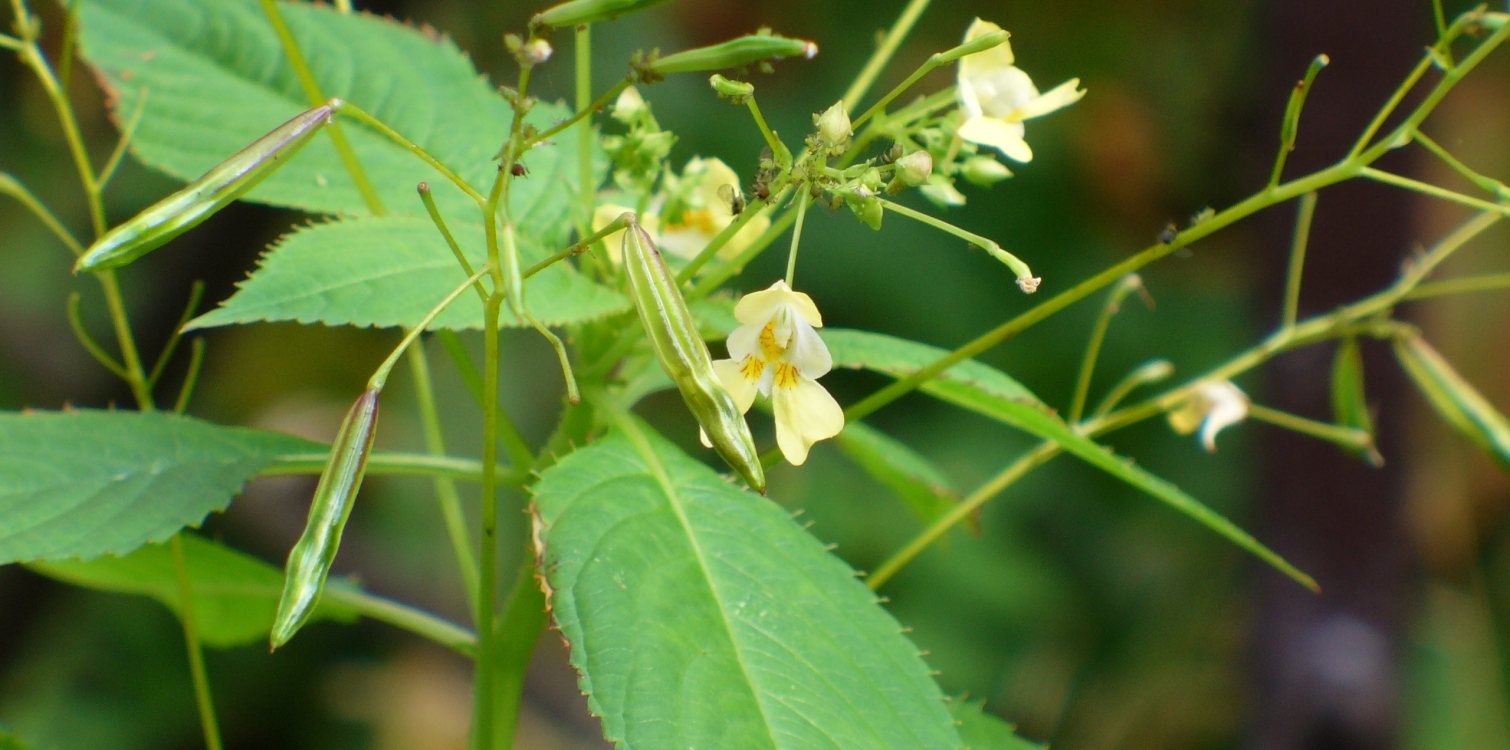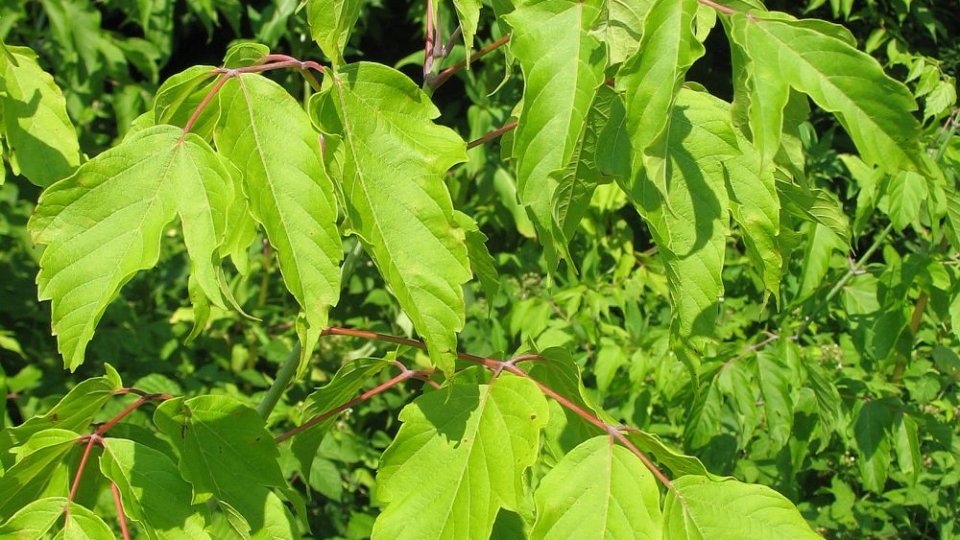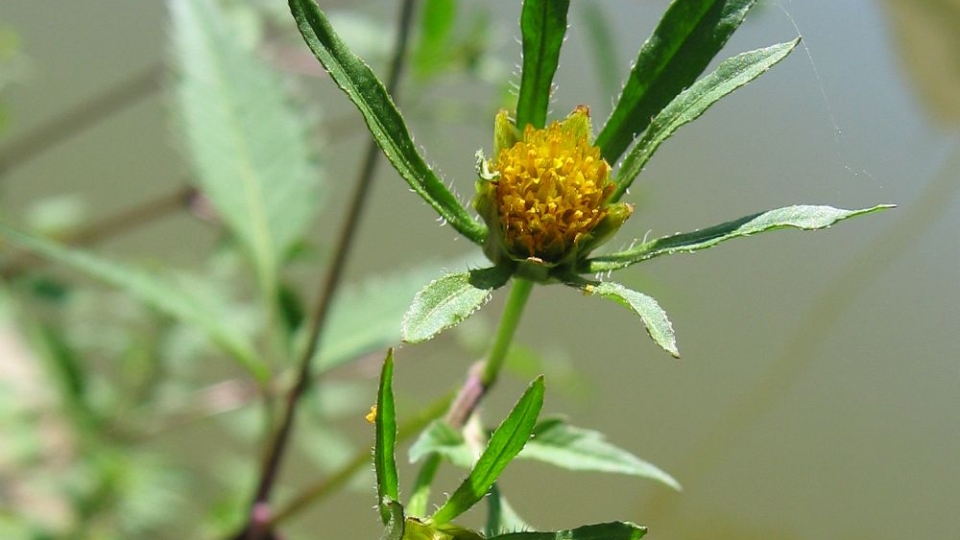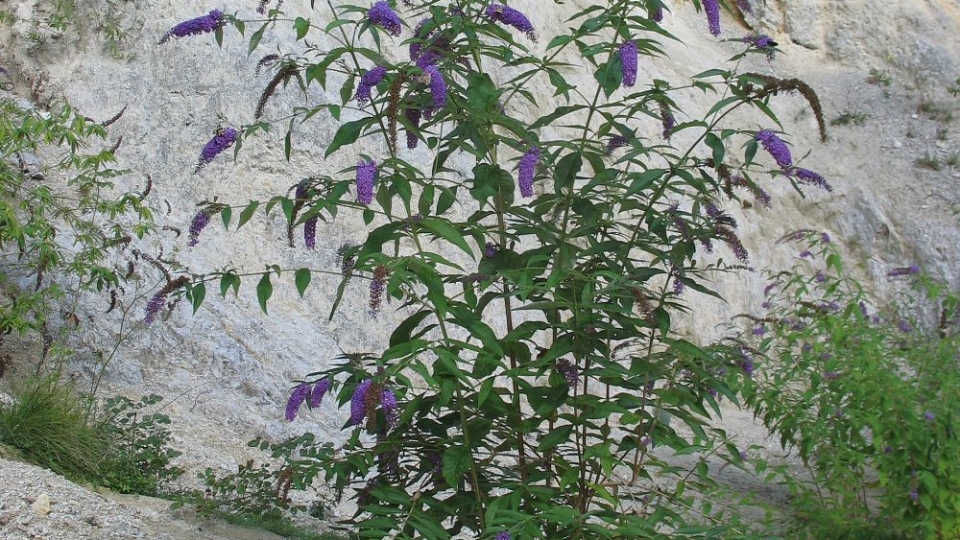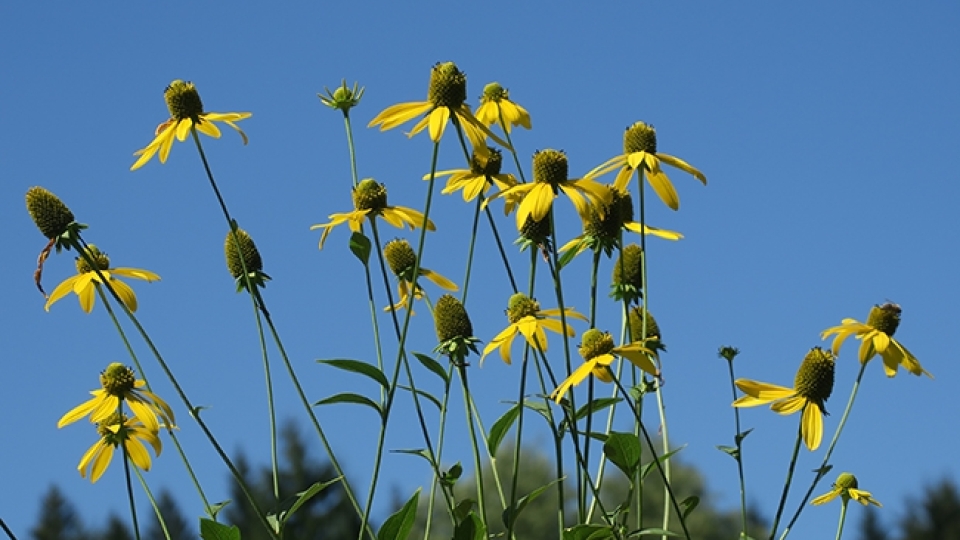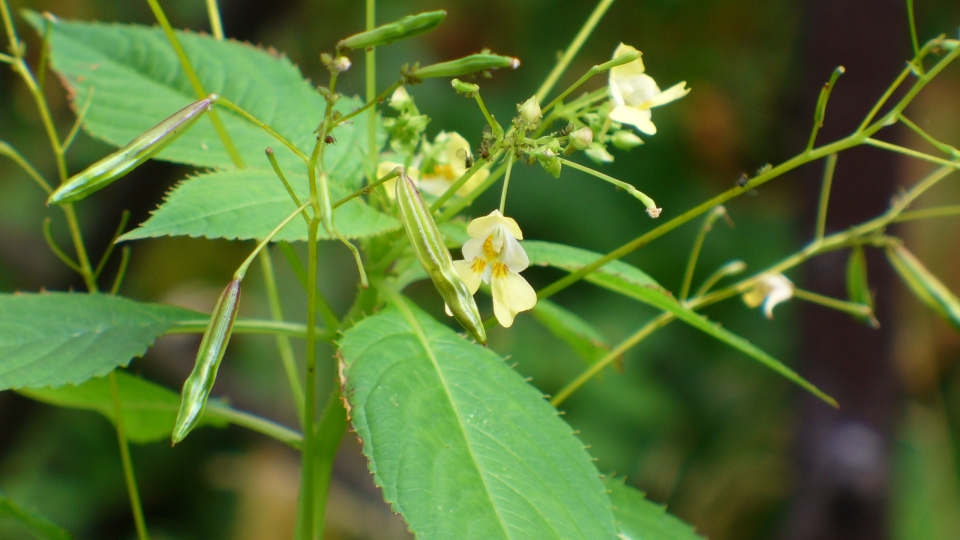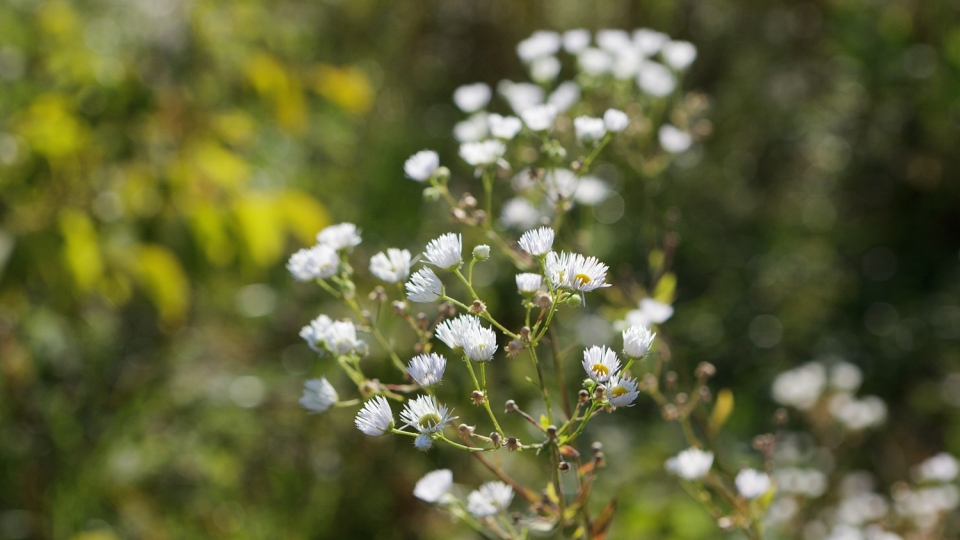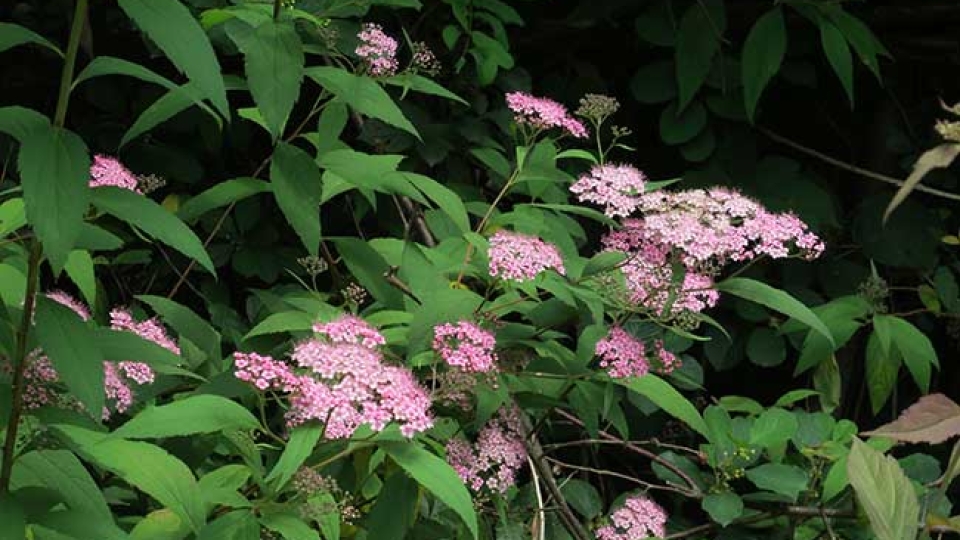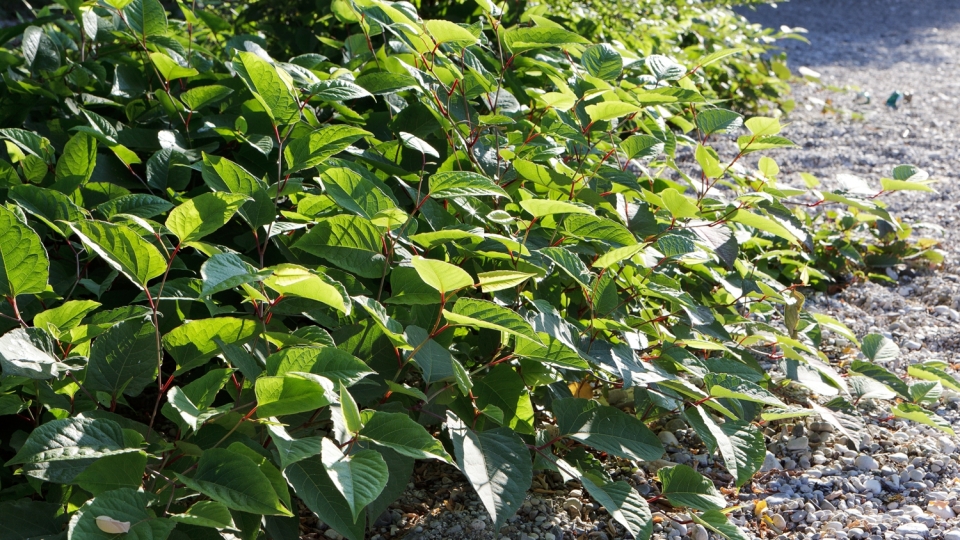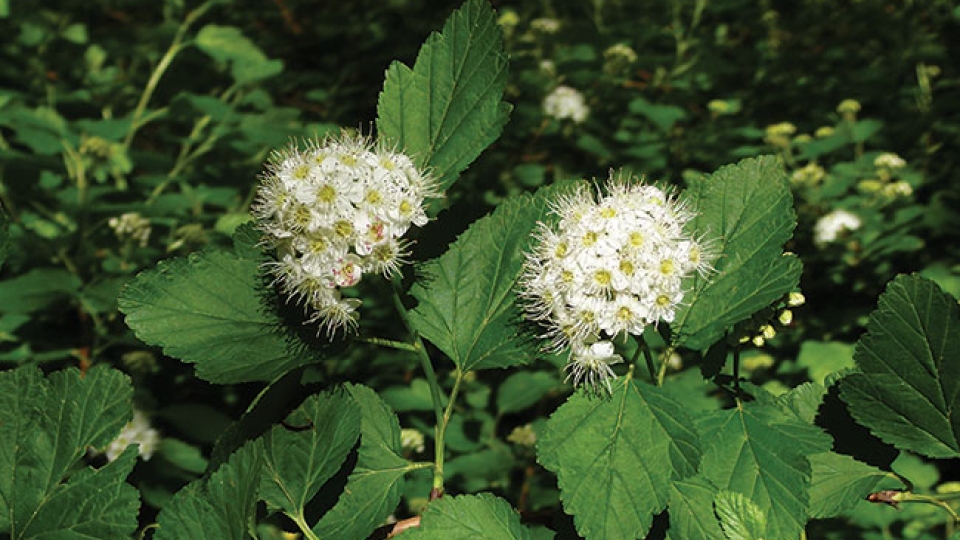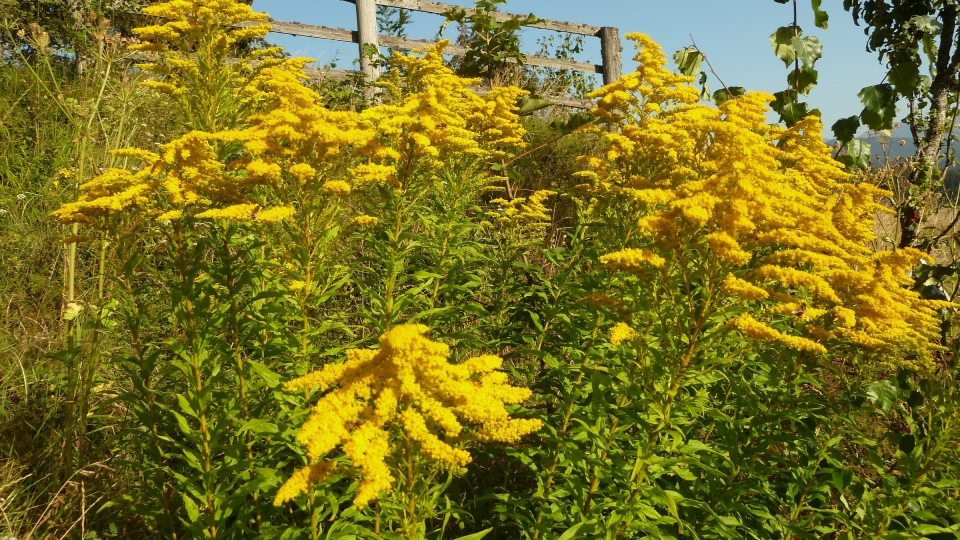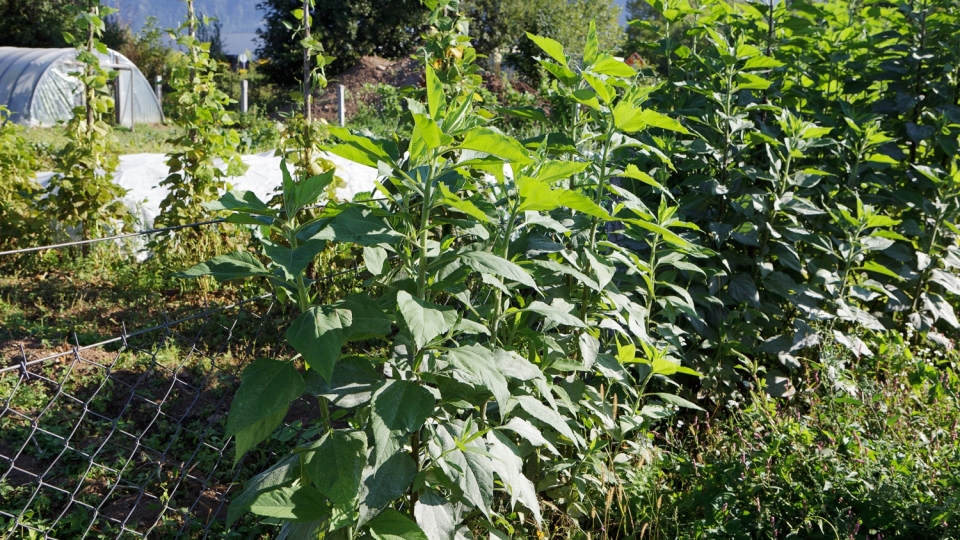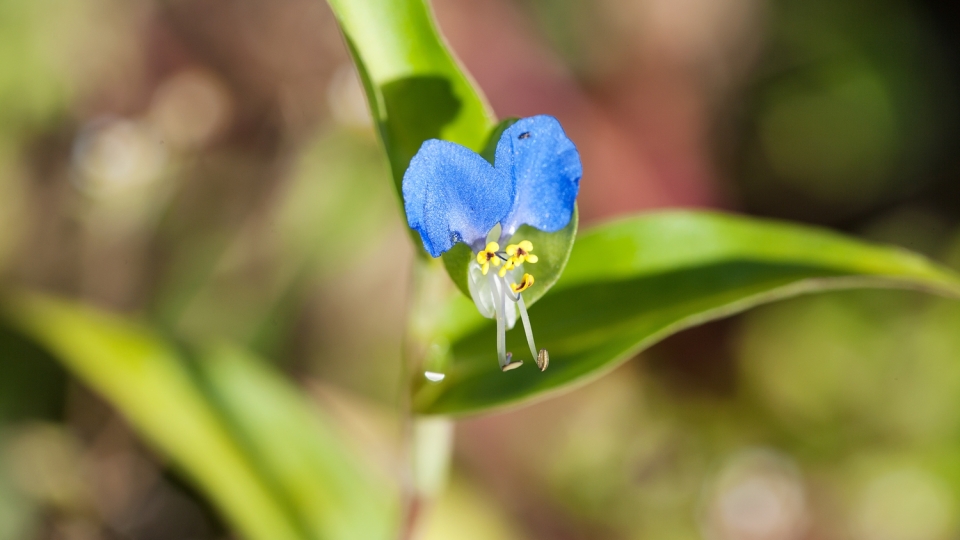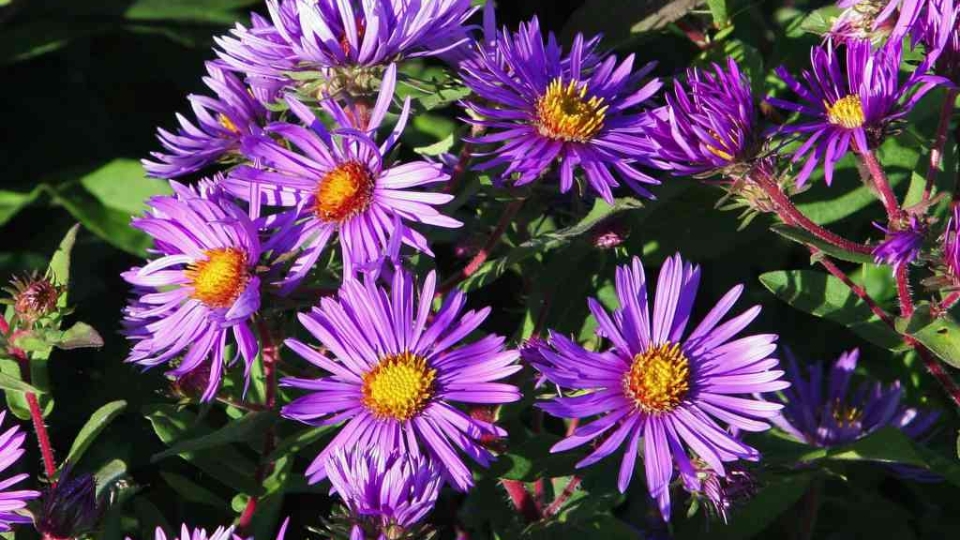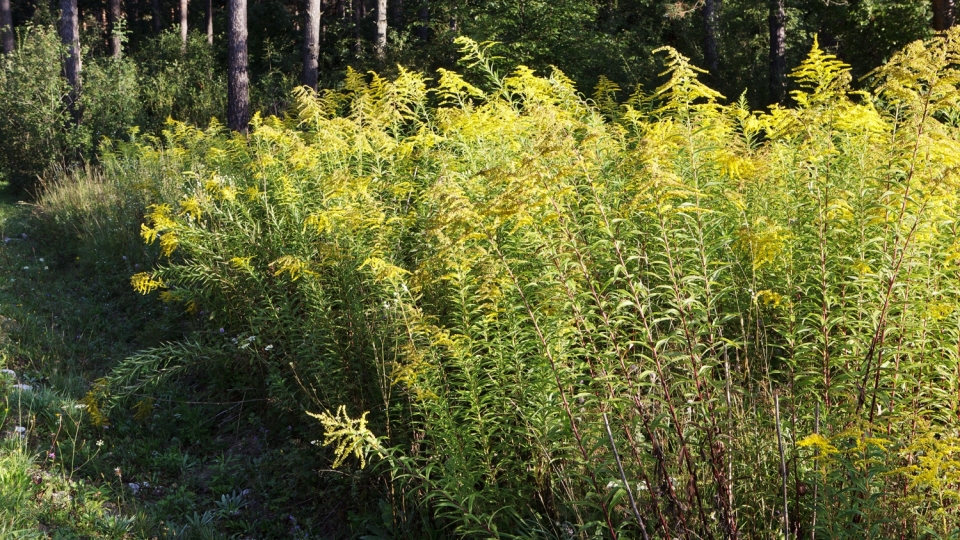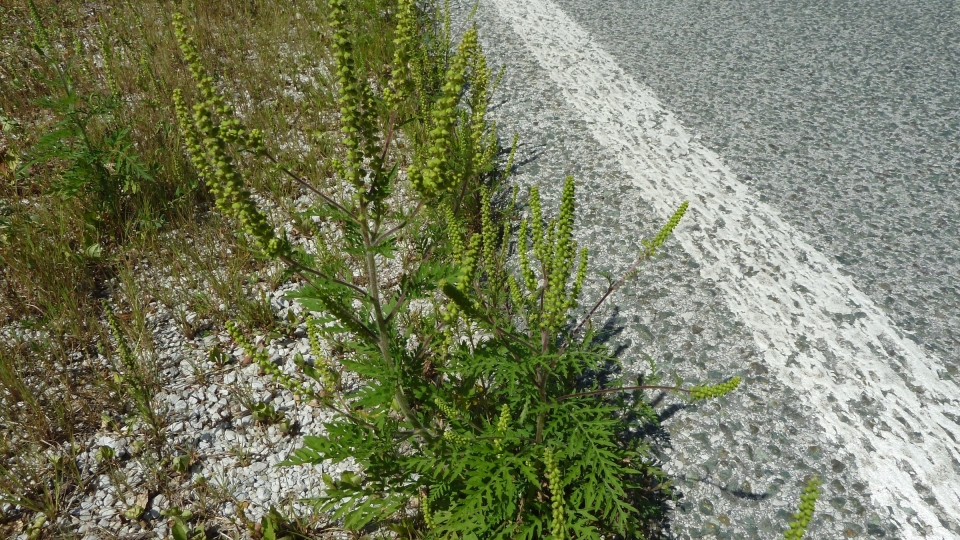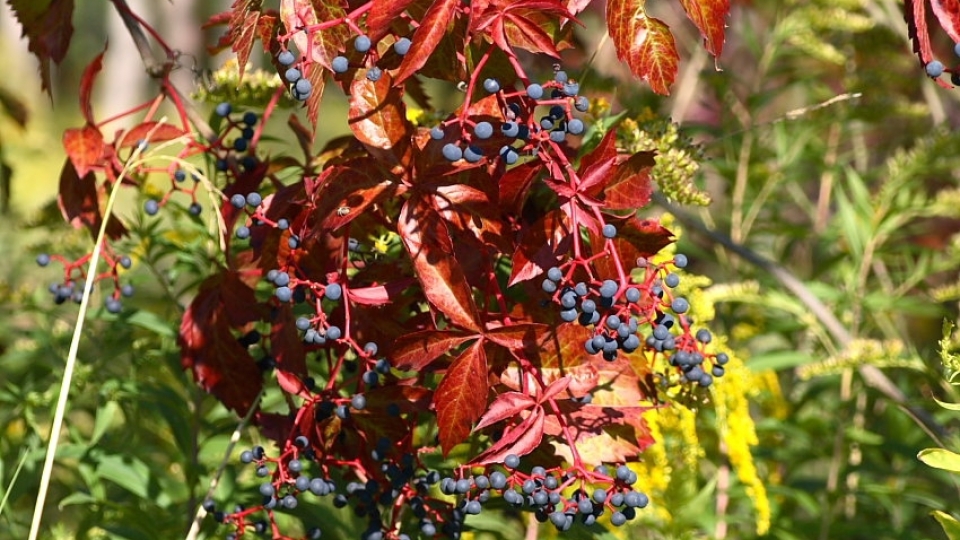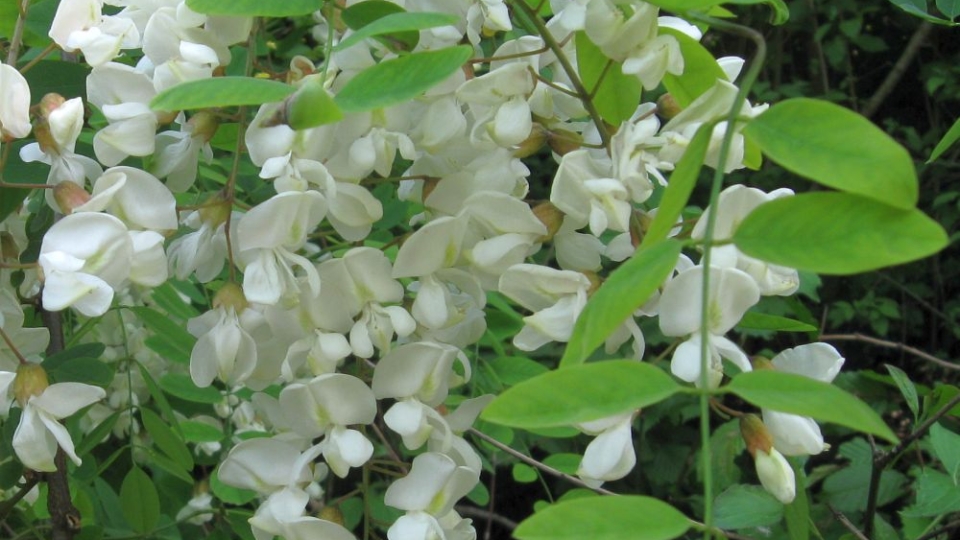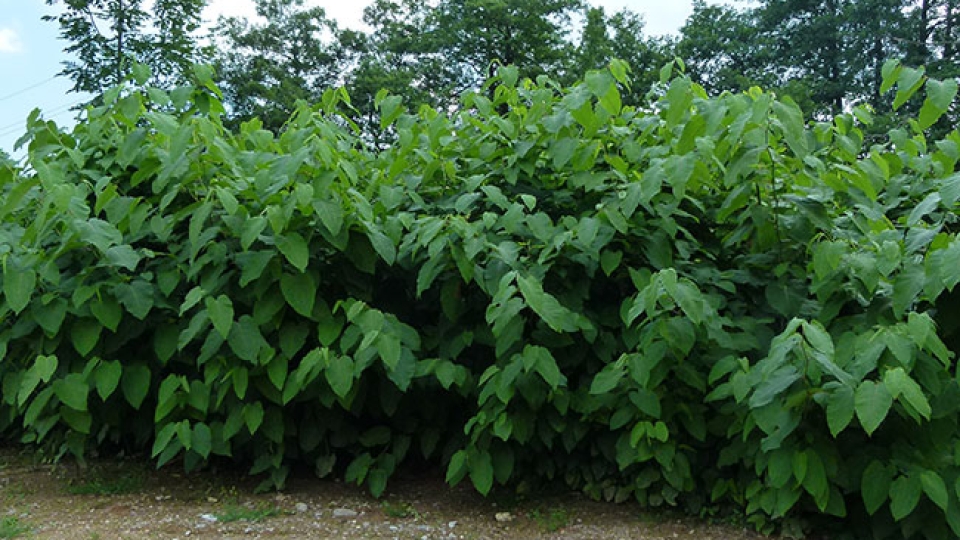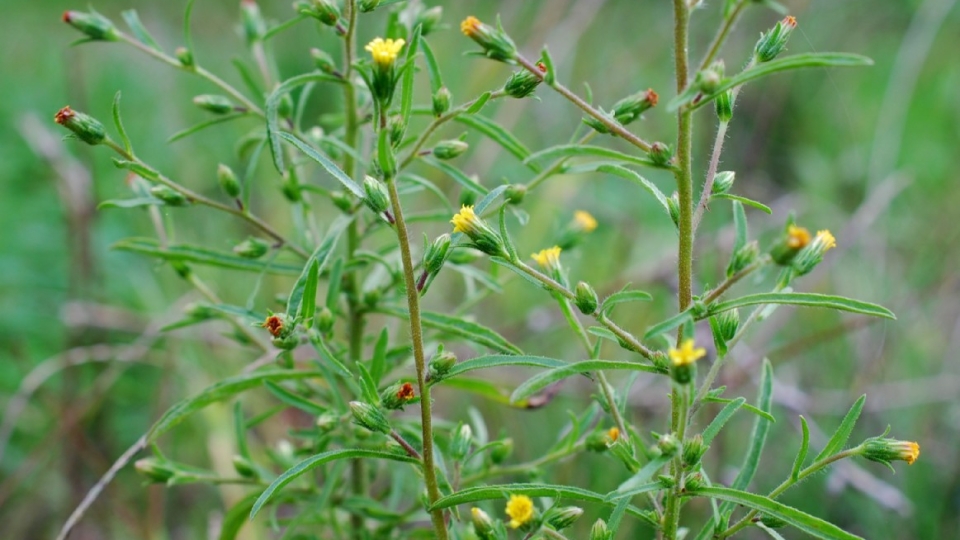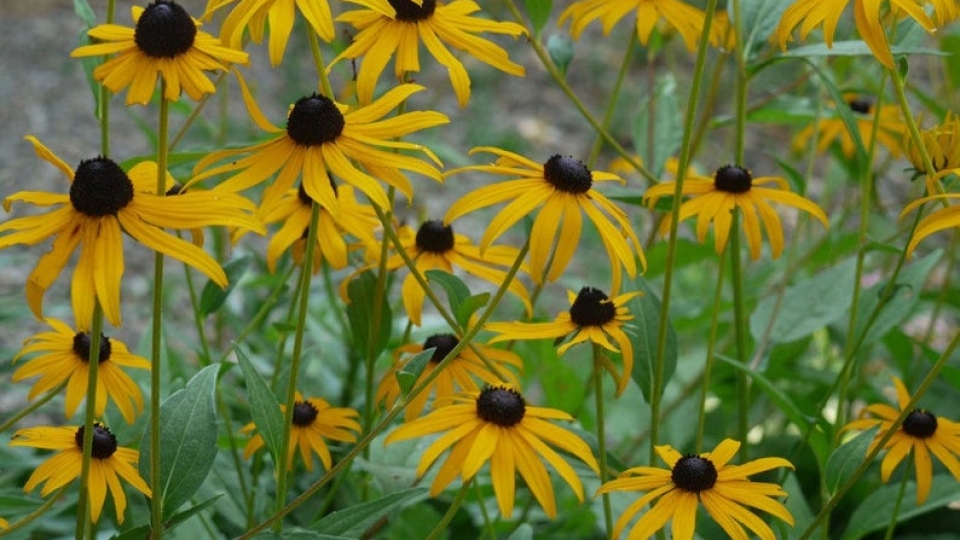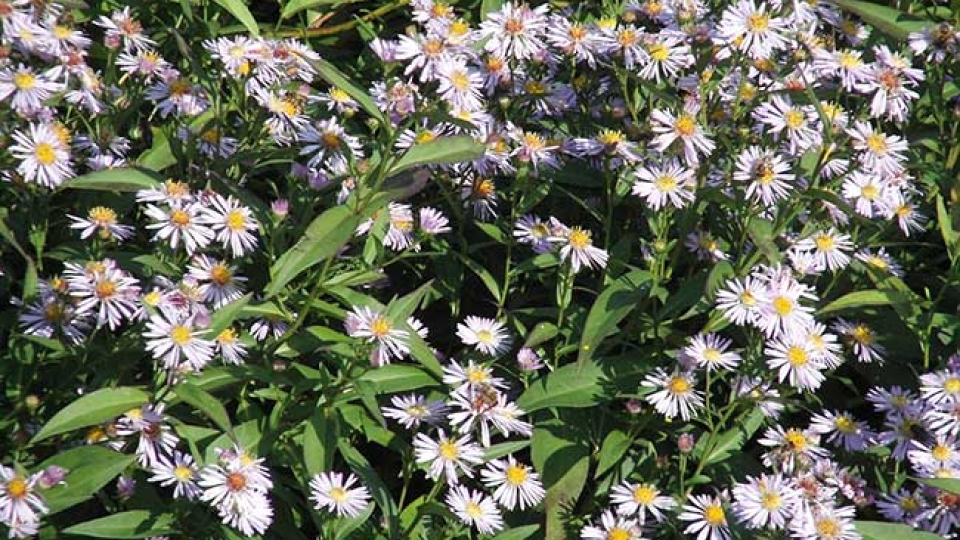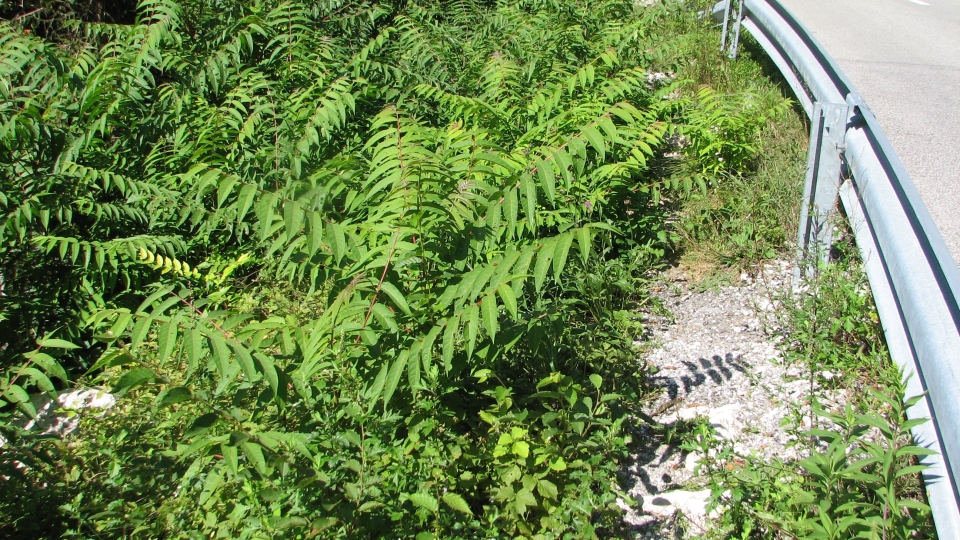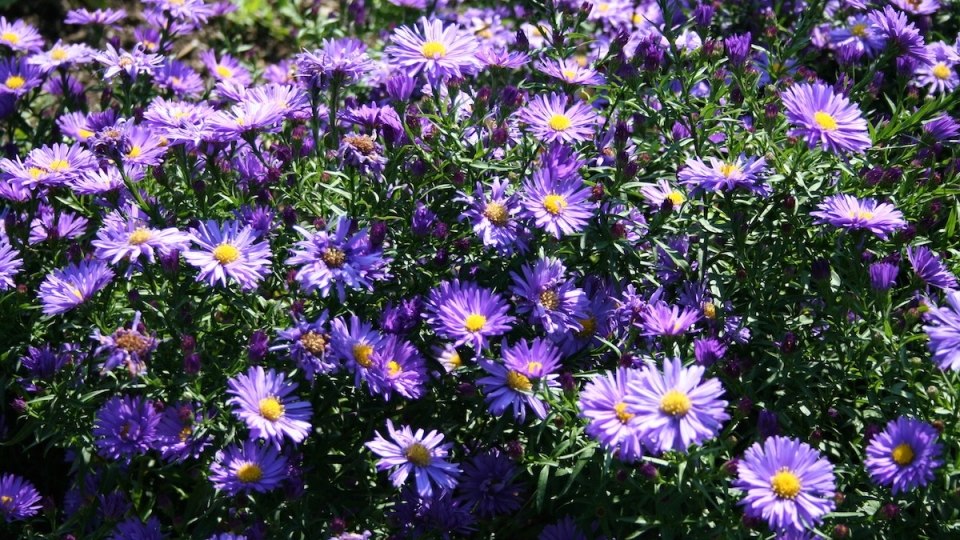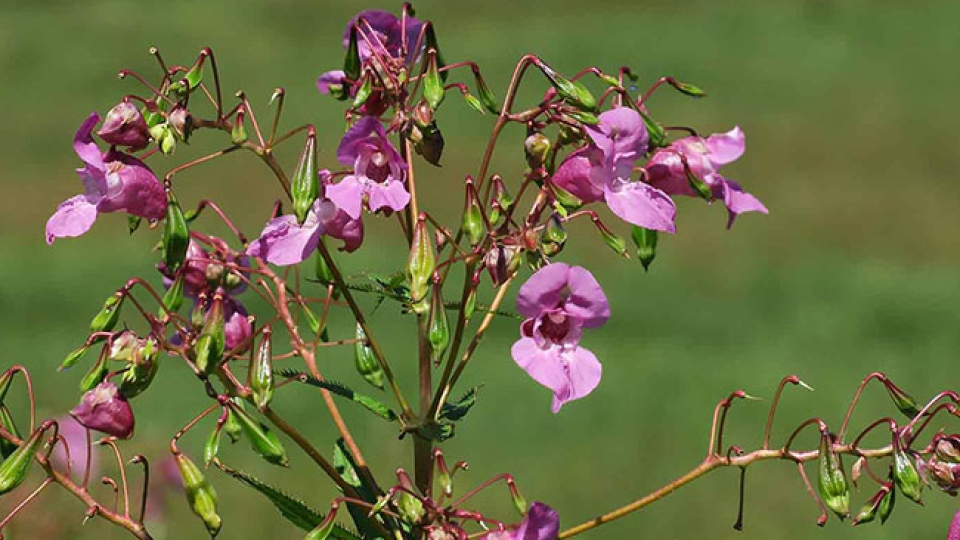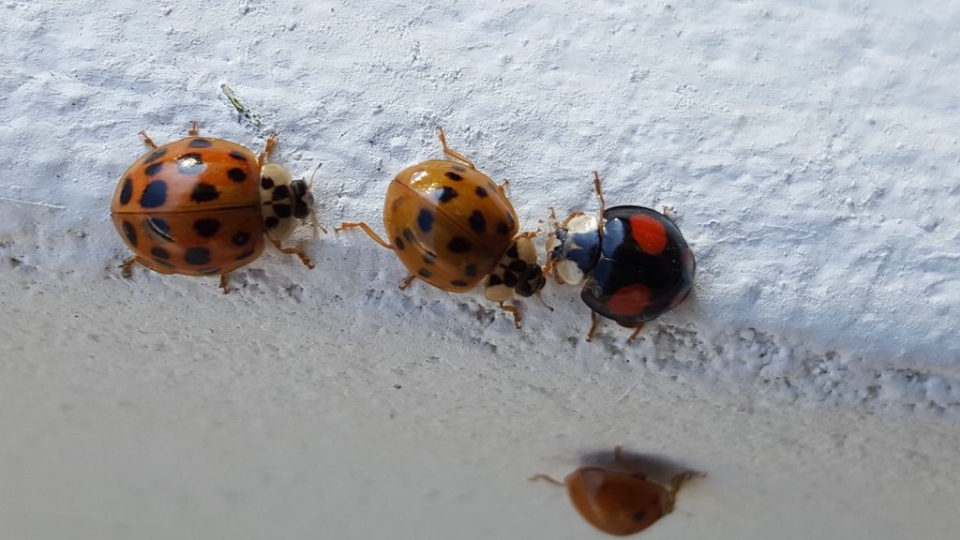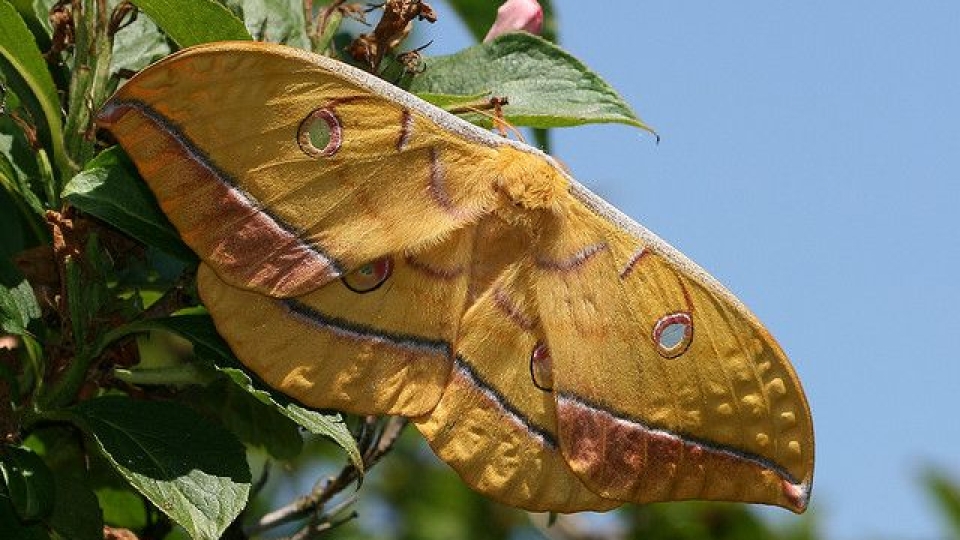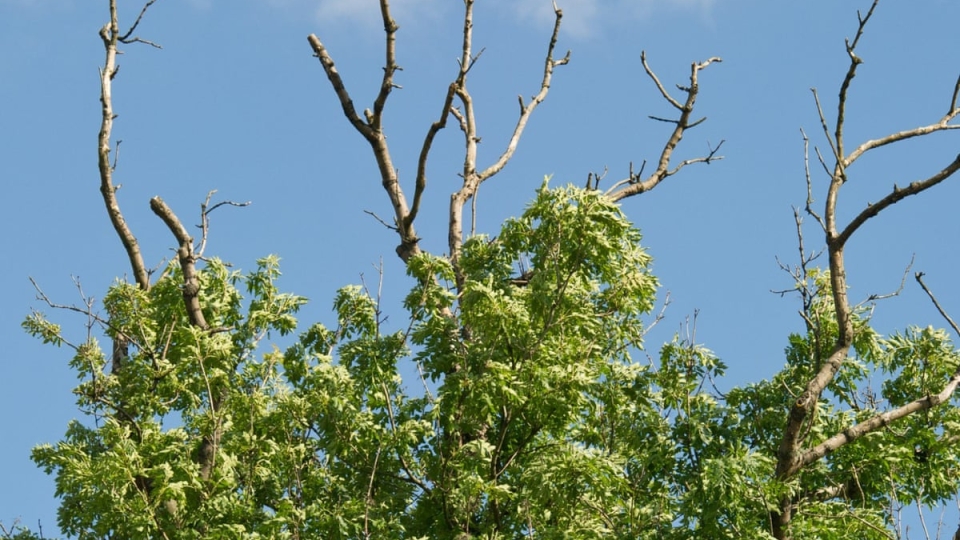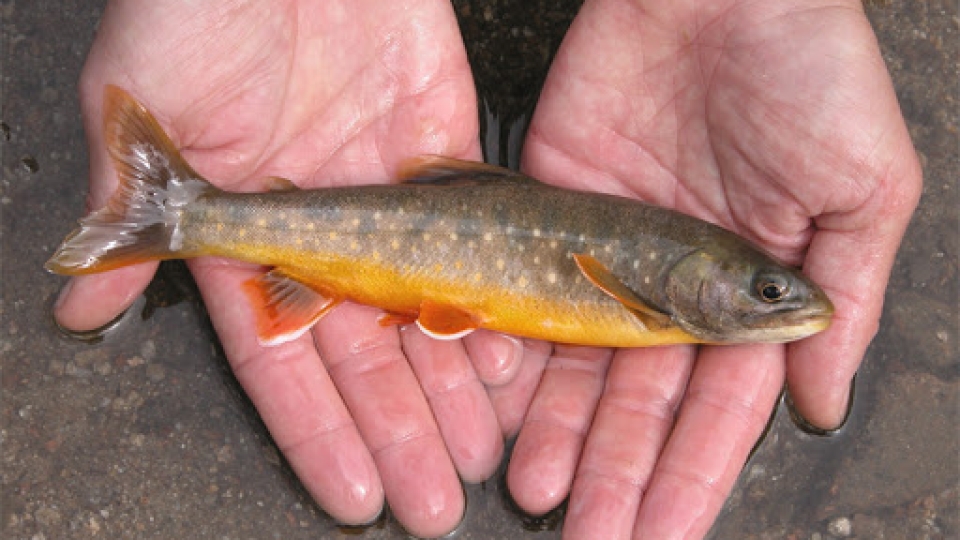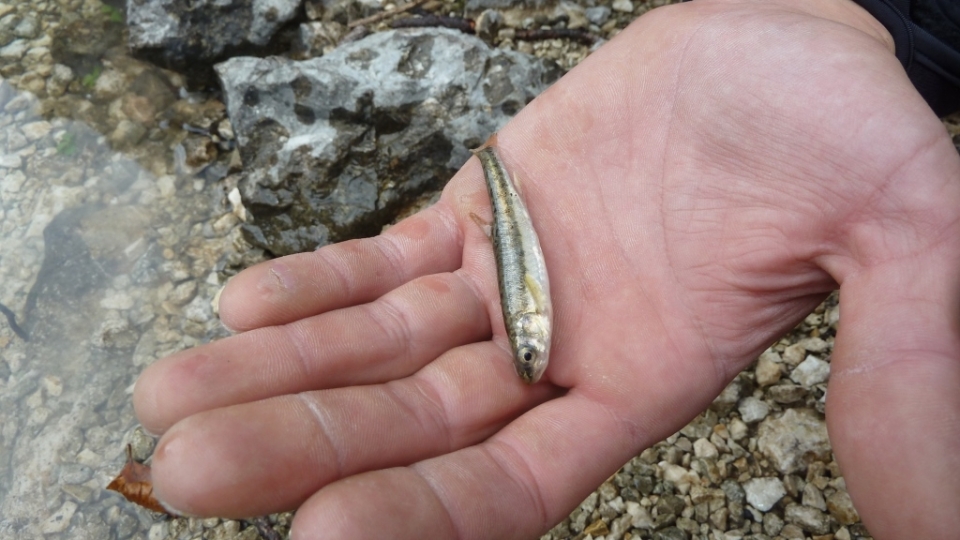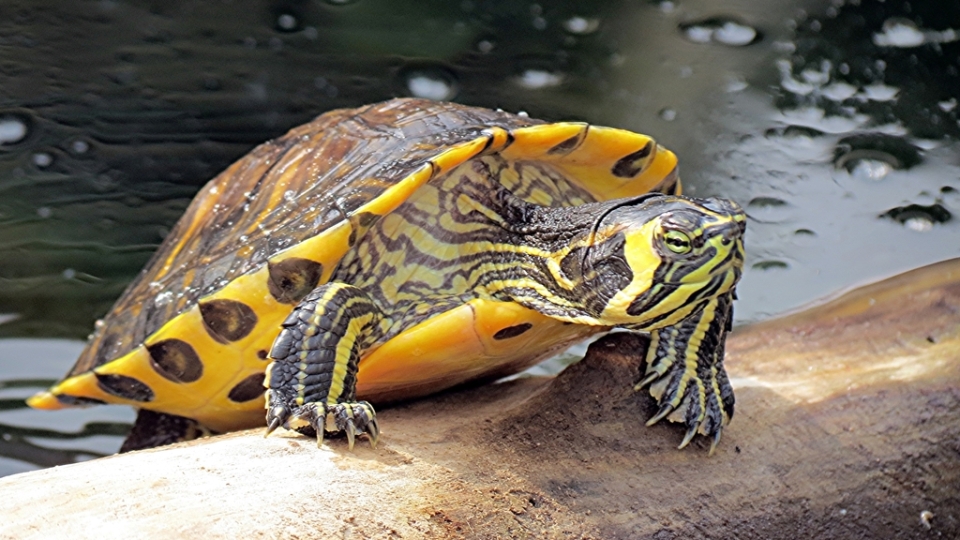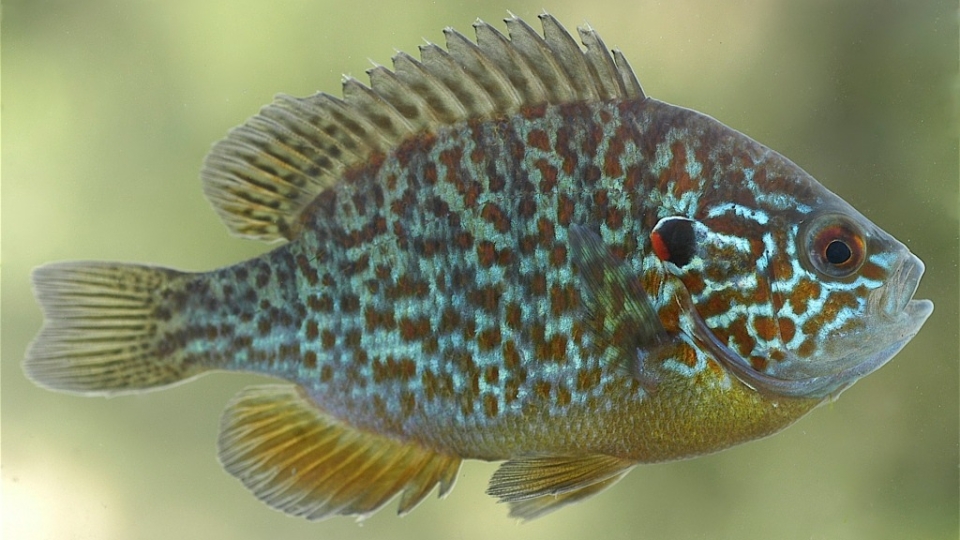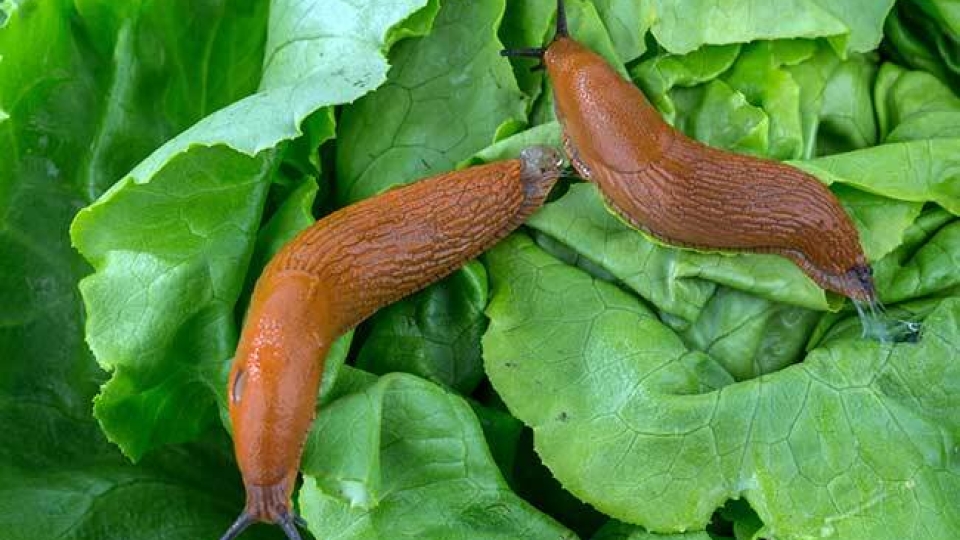According to current data, 24 non-native plant species are known to occur in the Triglav National Park. Some of them are highly invasive and occur in many locations.
Non-native animal species are also introduced. Their distribution is poorly known, as they are often tiny species that are difficult to spot.
Let us know about any new observations
Please use the list to alert us as soon as possible to the occurrence of new non-native species and contribute to the maintenance of the biotic balance. If possible, please provide accurate GPS coordinates and images.
- Ash-Leaf Maple
- Devil's Beggarticks
- Butterfly Bush
- Cutleaf Coneflower
- Small Balsam
- Annual Fleabane
- Japanese Spirea
- Japanese Knotweed
- Common Ninebark
- Canada Goldenrod
- Jerusalem Artichoke
- Asiatic Dayflower
- New England Aster
- Giant Goldenrod
- Common Ragweed
- Virginia Creeper
- Black Locust
- Giant Knotweed
- Stinkwort
- Black-eyed Susan
- Panicled Aster
- Tree-of-Heaven
- New York Aster
- Himalayan Balsam
Ash-Leaf Maple
(Acer negundo)- Origin:
- North America
- Description:
- Deciduous tree, the bark of the younger branches is smooth and green. The leaves are oppositely arranged and feathery, consisting of 3-5 short-petioled leaflets, the uppermost sometimes three-lobed. The species is dioecious. Inflorescences are many-flowered, pendulous and long-stalked. Fruits split into two winged nuts.
- Growing site:
- Often planted as an ornamental tree, spreading in riparian forests, stream banks, forest edges and ruderal sites. It can form dense stands in floodplains and river banks.
- Reproduction:
- Sexually by seeds dispersed by wind and water, vegetatively by rooting very brittle branches.
- Removal:
- Young plants are dug up and the larger ones are cut above ground, but there is a good chance that the plants will sprout again. The process therefore need to be repeated until the reserves in the roots are exhausted, which can take several years. Remove the branches and underground parts and incinerate them, as they may re-root. The fruits are also burned, as the seeds are well germinated.
- Warnings:
- American maple pollen is an allergen.
Devil's Beggarticks
(Bidens frondosa)- Origin:
- North America
- Description:
- Up to 1.2 m tall annual herb with branched russet-red stem. At least the lower leaves are divided into 3-5 cotyledons, which are ovate-acuminate to lanceolate, long-acuminate, toothed and short-stalked. The outer sheaths are 6-10 and are similar to the stem leaves. Fruits flattened, up to 10 mm long, with two bristles.
- Growing site:
- Moist to wet ground, cultivated or uncultivated, water banks, along water channels, forest track.
- Reproduction:
- From seed, flowering August-September. The fruits are also spread by humans, as they cling successfully to shoes or trousers.
- Removal:
- Hand-pulling plants, preferably before flowering.
- Warnings:
- /
Butterfly Bush
(Buddleja davidii)- Origin:
- East Asia
- Description:
- Deciduous shrub up to 4 m tall, with lance-shaped leaves and serrate margins. They are greyish on the underside due to densely set star-like hairs. The flowers are borne in long, dense inflorescences at the ends of the branches. The panicle is tubular, purple or other shades (pink, red, white, blue-purple). The flowers attract butterflies. The fruits remain on the plant, releasing seeds throughout the winter.
- Growing site:
- An ornamental shrub that likes to go wild and then settle in warm places such as: rock crevices, dry ruderal places, roadsides, gravel pits, sand pits.
- Reproduction:
- By seed and vegetatively by rooting shoots.
- Removal:
- Young plants are uprooted, older ones are cut down or burnt, and underground parts are dug up. Ring-cutting of the bark is also effective. Inflorescences should be cut back immediately after flowering to prevent seed dispersal. Above-ground and underground parts should be burned. In the area of a large vacant site, the site should be replanted with native pioneer plants.
- Warnings:
- Cut branches root easily.
Cutleaf Coneflower
(Rudbeckia laciniata)- Origin:
- North America
- Description:
- Herbaceous perennial up to 2.5 m tall, with tough rhizomes in the soil. Stems are glabrous, at least the lower leaves are pinnately divided, the middle leaves are trifid to peternate, at least below and marginally short-lobed. The leaf segments are lanceolate. The panicles measure 7-12 cm across, the tongue-shaped flowers are golden yellow, the tubular flowers greenish to brownish. The fruits are corymbs about 5 mm long with 4 short teeth on one side.
- Growing site:
- Rudbeckia are often planted as ornamentals. In nature, they are found in floodplains of rivers, forest edges and logging areas.
- Reproduction:
- It propagates successfully by cutting the rhizomes, and a new plant can grow from a piece of rhizome just over 1 cm long. It also spreads in stands by underground branching, which is accelerated if the plants are cut down. It also reproduces by seeds, which remain germinable for at least 3 years.
- Removal:
- Young plants are uprooted by hand before flowering. Larger stands are more difficult to uproot. Regular removal of the above-ground parts will weaken the stand, and only after several years of removing the above-ground shoots can we expect to eradicate the plants. Flowers, fruits and excavated underground parts should be disposed of by burning.
- Warnings:
- /
Small Balsam
(Impatiens parviflora)- Origin:
- Central Asia
- Description:
- Up to 0,6 m tall, stalk spreading, succulent. Leaves pendulous, broadly lanceolate and obtusely toothed, 3-12 cm long, flowering in awned panicles on stalked shoots, pale yellow, mouth dark yellow. Together with the flat spur 1-2 cm long. Fruits are conical and explosively eject seeds at maturity.
- Growing site:
- Shady areas, forest edges, undergrowth of wet forests, shady ruderal sites.
- Reproduction:
- From seed, it flowers from June to September, and the seeds are ripe from July to October.
- Removal:
- In smaller stands, plants are hand-pulled before flowering. Multiple mowing before flowering could also be effective. Plants that are fruiting eject seeds on contact, so it is impossible to remove them without sowing some seeds. Fruit-bearing plants should be sent for incineration.
- Warnings:
- /
Annual Fleabane
(Erigeron annuus)- Origin:
- North America
- Description:
- Annual, biennial or perennial, with erect, branched, scattered hairy stems. The light green leaves are hairy on both sides, the lower ones obovate-ovate to 10 cm long, the upper ones lanceolate to dart-shaped, toothed to entire-edged, up to 9 cm long. The white tongue-shaped and yellow tubular flowers are clustered in numerous15-20 mm wide clusters.
- Growing site:
- Mining sites, uncut grassland, fields, abandoned arable land, gravel pits, road verges and green spaces. Already widespread throughout Slovenia, up to an altitude of about 1000 m above sea level.
- Reproduction:
- From seed, it flowers from May to November.
- Removal:
- Pulling the plants and repeated mowing over several years until the plant is exhausted.
- Warnings:
- /
Japanese Spirea
(Spiraea japonica)- Origin:
- East Asia (Japan, China, Korea).
- Description:
- Deciduous shrub with spirally arranged simple broadly umbellate leaves on wiry, branched, erect stems, brown to reddish-brown, sometimes hairy. Flowers are pinkish, with individual sepals at least 5 cm across, developing at the ends of the branches. Young shoots are reddish, leaves sharply double-toothed, gradually acuminate. Great variability due to the many cultivated forms.
- Growing site:
- Riparian areas, marshes, wetlands, forest edges, along paths, clearings, mineral sites. Allows partial shading, but not long-wetted soils. It is invasive mainly as an understory plant of forests on acid soils.
- Reproduction:
- Seeds are spread by water, but they can also be spread unintentionally on clothes, shoes or by passing them through the fingers.
- Removal:
- Low mowing before flowering at least once a year and for several years in a row can severely deplete populations, but usually does not kill them. The method is suitable for controlling small populations in more easily accessible terrain. In less accessible sites where mowing is not possible, smaller Medfly plants (Figure 3) are removed by plucking, while larger ones are removed by cutting the shoots just above the ground. Removal should be repeated several times a year and the situation monitored and repeated over several years. Large populations can be controlled with herbicides, but these should only be used by people with all the necessary certificates and permits in a way that does not harm people or the environment! To prevent further spread, removal should be carried out before seed set.
- Warnings:
- /
Japanese Knotweed
(Fallopia japonica)- Origin:
- East Asia
- Description:
- Herbaceous perennial up to 2 m tall, with bushy stems and woody underground rhizomes that can reach several metres deep and wide. Stem hollow and knob-shaped, leaves short-petioled, broadly ovate with a truncate base, up to 15 cm long, smooth to the touch. The white flowers are small, in dense clustered inflorescences. Only the female plants occur here, and they do not develop many fruits.
- Growing site:
- Mining sites, watercourse banks, forest edge, forest clearings, meadows, road edges. The stands are usually very dense and devoid of other plants.
- Reproduction:
- Vegetatively, all parts of the stem take root easily, with young plants sprouting from small pieces of rhizome. Sexual reproduction by seeds in source areas where male and female plants are present.
- Removal:
- Smaller populations require regular, multi-year mowing or pulling of young shoots and digging out of rhizomes. Careful handling of waste material is essential! Sheep grazing and covering plants with thick felt over several years can also help. Controlled chemical removal with herbicides (contact application or injection) is also successful in small areas.
- Warnings:
- /
Common Ninebark
(Physocarpus opulifolius)- Origin:
- North America
- Description:
- Up to 3 m tall, the bark peels off in longitudinal strips, making it shiny in winter. Leaves are broadly ovate in outline, up to 10 cm long, 3-5-trunked, with toothed rags. The flowers, which are borne in hemispherical cymes, are white, 1 cm across. The fruits are bright, blister-like, inflated polygamous lobes which turn red at maturity and burst open in autumn to scatter the seeds.
- Growing site:
- Ornamental shrub that is wild and naturalised on riverbanks, in meadows and along woodland edges.
- Reproduction:
- Vegetatively by rooting the branches, so they should not be dumped in the wild. It also reproduces sexually by seeds. Flowering time May-July, seed maturity August-November.
- Removal:
- The bushes are cut down and the underground parts are dug up. Ring-cutting the bark also works. This involves cutting a strip of bark around the trunk, about 10 cm wide, to prevent the flow of material through the plant. Seed reproduction is prevented by cutting off the dead inflorescences before they develop into fruit. Any parts of the plant that are removed should be incinerated as they may take root.
- Warnings:
- /
Canada Goldenrod
(Solidago canadensis)- Origin:
- North America
- Description:
- Herbaceous perennial, up to 2 m tall. Stem above (especially in inflorescence) densely hairy. At the top of the shoots, the yellow flowers are clustered in tiny clusters, 2-3 mm long, and the tongue-shaped flowers within them are barely longer than the tubular ones. The seeds are tiny, with a tuft of hairs at one end.
- Growing site:
- An ornamental plant that spreads to forest glades, forest edges, sparsely mown meadows, along watercourses and in ruderal places.
- Reproduction:
- By seeds, which are spread over long distances by the wind, and vegetatively, by the growth of rhizomes and their dismemberment. The pieces can be blown out with the soil. It flowers from August to October.
- Removal:
- Hand-excavate individual plants, taking care to remove all underground parts. The spread of small stands can be limited by mowing or removing plants before flowering. This prevents the introduction of new seeds into the soil seed bank and the germination of new plants. Frequent mowing will eventually deplete the nutrient reserves in the rhizomes and the plants will slowly die. According to various sources, mowing twice a year (May and August) for several years in a row can greatly reduce the stand of goldenrod. Flowering shoots and excavated underground parts should be submitted for incineration.
- Warnings:
- /
Jerusalem Artichoke
(Helianthus tuberosus)- Origin:
- North America
- Description:
- A branching perennial up to 3 m tall with tuberous, thickened rhizomes and a scraggly stem. Ovate-globose leaves coarsely toothed and petiolate, scabrous above, hairy below. The stem bears several long-stalked, large erect calyxes 4-8 cm across. All flowers are yellow, the outer tongue-shaped flowers are 2,5-4 cm long and 1 cm wide.
- Growing site:
- Deep, rich, moist soils along river and stream margins, forest edges, roadsides, embankments, sunny positions, also cultivated.
- Reproduction:
- Mostly vegetatively by tubers, rarely by seeds. It flowers in late summer and autumn, from September to November; the seeds do not ripen here.
- Removal:
- Plants are dug up with their tubers in spring and early summer. Mowing is also successful in larger stands and should be repeated twice a year, in late June and August. The tubers must be properly destroyed (e.g. by boiling or incineration).
- Warnings:
- Some people may be allergic to Jerusalem artichoke pollen.
Asiatic Dayflower
(Commelina communis)- Origin:
- East Asia
- Description:
- Comelina is a herbaceous perennial with a prostrate, branched stem up to 70 cm tall, which can root on stems. The leaf surface is broadly lanceolate, indistinctly petiolate. The inflorescence is 3- to 4-flowered, surrounded by a large, keeled umbel. The flowers are three in number, the inner three petals being the most conspicuous: the lower petal is white and tiny, the other two are large and blue. The fruit is dry, with 4 seeds in each, which are released when the fruit opens.
- Growing site:
- It is grown for ornamental purposes, but in the wild it is mainly found in shady and moist ruderal sites.
- Reproduction:
- Sexual by seed and vegetative by rooting of fallen stems. Flowering time: June-October, seed maturity: July-November.
- Removal:
- The plants are propagated or dug up before the seeds are mature. Seeds are long-lived, so we continue to observe the site where we have removed the plants for a few years and, if necessary, re-populate the new plants.
- Warnings:
- /
New England Aster
(Aster novae-angliae)- Origin:
- North America
- Description:
- Medium-sized, herbaceous, herbaceous perennial. Stems erect, less spreading. Leaves simple, ovate-ovate, entire-edged, without petiole, clasping the stem with awns, rough above, softly hairy below. Flowers numerous, in ovate clustered inflorescences, 40-100 tongue-shaped flowers, often bright pink. Sheathing leaves in 3-5 layers, narrow, protruding.
- Growing site:
- Planted as an ornamental plant in gardens, ruderal sites, forest edges, scrub, river banks, embankments, abandoned quarries.
- Reproduction:
- It flowers in July and August, seeds are spread by wind, vegetatively by shoots from the hive and roots.
- Removal:
- Digging up plants and mowing frequently. Preventive removal of stems immediately after flowering to prevent possible seed development.
- Warnings:
- /
Giant Goldenrod
(Solidago gigantea)- Origin:
- North America
- Description:
- Herbaceous perennial up to 2.5 m tall. It differs from the Canadian goldenrod by having a bare stem, which may be a little whitish and downy. Giant goldenrod has larger yellow calyxes (3-4 mm long), the tongue-shaped flowers are distinctly longer than the sheath and tubular flowers.
- Growing site:
- An ornamental plant that spreads to forest glades, forest edges, sparsely mown meadows, along watercourses and in ruderal places around settlements.
- Reproduction:
- By seeds, which are spread over long distances by the wind, and vegetatively, by the growth of rhizomes and their dismemberment. The pieces can be blown out with the soil. It flowers from August to October.
- Removal:
- Hand dig individual plants, taking care to remove all underground parts. Limit the spread of small stands by mowing or removing plants before flowering. This prevents the introduction of new seeds into the soil and the germination of new plants. Frequent mowing will eventually deplete the nutrient reserves in the rhizomes and the plants will slowly die. According to various sources, mowing twice a year (May and August) for several years in a row can reduce stands significantly. Flowering shoots and excavated underground parts should be submitted for incineration.
- Warnings:
- /
Common Ragweed
(Ambrosia artemisiifolia)- Origin:
- North America
- Description:
- Annual, 5 cm to 2 m tall, spreading plant, leaves similar to wormwood, spirally arranged, twice pinnately divided, petiole with long protruding hairs. The male inflorescences are developed in a long erect spike at the top of the plant, the female inflorescences are inconspicuous, in foliage. The fruit is a nut.
- Growing site:
- Dry ruderal sites, roadsides, railways, fields, near bird feeders, over-wintered parts of lowland forests.
- Reproduction:
- It flowers from July to October, windflowering and self-pollinating. It has very hardy, long-lived seeds that survive in the soil for decades. Spread by vehicles, agricultural and construction machinery.
- Removal:
- It is important to prevent the plant from developing seeds. Populate young plants (gloves!), repeated mowing, hoeing before seeds develop, burning, herbicides (not recommended).
- Warnings:
- A very allergenic plant.
Virginia Creeper
(Parthenocissus quinquefolia)- Origin:
- Japan
- Description:
- A woody climber with long-stalked, palmately compound leaves of 5-7 leaflets. These are broadly stalked, toothed and short-stalked, 5-15 cm long. In autumn they turn a distinct vivid red. The opposite side of the leaves develops a branched tendril. The broad clustered inflorescences are composed of five-flowered racemes. The yellow-green corolla leaves are about 3 mm long, the sepals are stalked. The fruits are dark blue, roundish berries with a peppery appearance. Two closely related species grow here, differing in the following characters: P. inserta has normal tendrils, sessile petals and a hump-shaped inflorescence; P. quinquefolia: tendrils have a grasping plate, short-petioled petals and a lobed inflorescence; P. quinquefolia: tendrils have a grasping plate, short-petioled petals and a lobed inflorescence; P. quinquefolia has a hump-shaped inflorescence.
- Growing site:
- Cultivated for ornamental purposes, wild and naturalised on ruderal sites, abandoned quarries, forest edges, floodplain forests.
- Reproduction:
- Vegetatively by spreading on the ground and rooting the shoots, sexually by seed. The ripe berries are dispersed by birds from autumn to spring.
- Removal:
- If possible, remove it as soon as it appears, as this is when the chance of removal is greatest. For older plants, look for the main woody stem and saw it through, pulling off any creeping shoots that may have taken root. All shoots should be dried and incinerated as they root well. Care should be taken with fruiting plants as the seeds in ripe strawberries will take several years to germinate.
- Warnings:
- Strawberries are poisonous to humans and other mammals! They can cause skin inflammations in sensitive people.
Black Locust
(Robinia pseudacacia)- Origin:
- North America
- Description:
- Up to 25 m tall tree with longitudinally fissured greyish-brown bark. Leaves are odd-lobed, with 3-10 pairs of leaflets. They are ovate, short-stalked, 2-5 cm long, with the appendages transformed into spines. The flowers are butterfly-shaped, white, fragrant, clustered in drooping clusters. Fruits are multi-seeded pods up to 10 cm long.
- Growing site:
- Forest edges, clearings, embankments, riparian areas and near settlements. Also cultivated as an ornamental and honey-bearing plant.
- Reproduction:
- Seeds that germinate well for at least 10 years germinate particularly well after fires. Flowering time: May-June. It also reproduces by underground branching, which shoots up massively, especially after the main trunk has been removed.
- Removal:
- Blackberry trees are very difficult to remove. If the main trunk is cut down, young shoots start to sprout from the roots and the stump. Repeated cutting/pruning of the shoots will eventually kill the plant.
- Warnings:
- The plant has sharp spines on its branches.
Giant Knotweed
(Fallopia sachalinensis)- Origin:
- East Asia
- Description:
- Herbaceous perennial up to 4 m tall, leaves are oblong-ovate with a heart-shaped base, up to 40 cm long, thin and rough to the touch. Flowers female or bisexual, small, whitish, fruit a triangular black nut.
- Growing site:
- Settlements, along paths, in damp places at forest edges. In dense stands.
- Reproduction:
- Vegetatively from stem fragments, rhizomes and seeds. It flowers from July to September.
- Removal:
- Smaller populations require regular, multi-year mowing or pulling of young shoots and digging out of rhizomes. Careful handling of waste material is essential! Sheep grazing and covering plants with thick felt over several years can also help. Controlled chemical removal with herbicides (contact application or injection) is also successful in small areas.
- Warnings:
- /
Stinkwort
(Dittrichia graveolens)- Origin:
- Mediterranean (N Africa, Middle East, SE Europe)
- Description:
- Up to 50 cm tall, branched, erect annual with numerous quizzical side shoots. It is sticky to the touch because it is covered with glandular hairs and has a strong smell reminiscent of camphor. The leaves are mostly narrower than 10 mm and serrated. The pods are small and cylindrical, up to 5 mm wide, and abundantly cover the shoots.
- Growing site:
- It occurs most often on ruderal and anthropogenic sites, on dry and warm sandy or coarse soils that are poor in minerals. In our country, it occurs mainly along motorways, where it forms compact stands, but it can also occur on arable land and abandoned fields, along railways, in quarries, etc.
- Reproduction:
- Seeds, which have a short lifespan.
- Removal:
- Plucking, frequent mowing before the plants go to seed. Chemical (herbicides) or biological measures (limiting soil amendment, maintaining dense vegetation cover).
- Warnings:
- Essential oils cause severe skin inflammation. The seeds cause inflammation of the small intestine and liver disease in livestock.
Black-eyed Susan
(Rudbeckia hirta)- Origin:
- North America
- Description:
- Annual to biennial, up to 100 cm tall, with simple, scabrous leaves. The flowers in clusters are colourful (yellow, orange, red), the inner tubular flowers are dark brown.
- Growing site:
- Cultivated for ornamental purposes, wild on drier ruderal sites, forest edges, close to settlements.
- Reproduction:
- Vegetatively by spreading shoots from rhizomes and by seeds.
- Removal:
- The plants are hand-pulled before fruiting. Any underground remains must be incinerated.
- Warnings:
- /
Panicled Aster
(Symphyotrichum lanceolatum)- Origin:
- North America
- Description:
- Tall herbaceous perennial, leaves lanceolate-oblanceolate, with a pointed apex, glabrous, mostly sessile. Many clustered inflorescences on the stem, 16-50 white tongue-shaped flowers per cluster. Green sheath leaves in several layers, oblanceolate or protruding, with a lighter underside. Fruits are florets with a curl of hairs.
- Growing site:
- Species cultivated for ornamental purposes, wild on ruderal sites, forest edges, river banks, embankments, abandoned quarries, etc.
- Reproduction:
- It flowers from September to October, spreading here mainly vegetatively, by underground nerve growth.
- Removal:
- Digging up plants and mowing frequently. Preventive removal of stems immediately after flowering to prevent possible seed development.
- Warnings:
- /
Tree-of-Heaven
(Ailanthus altissima)- Origin:
- East Asia
- Description:
- A deciduous slender tree with thick branches, the bark grey and smooth. It forms a broad canopy and also occurs as a multi-stemmed tree. Leaves spirally arranged, long, feathery compound. Leaflets entire, crenate, broadly stalked, truncate to cordate at base. Leaves have a distinct, unpleasant odour when crushed between the hands. The large and erect inflorescences are dioecious. The female plants develop long reddish-brown winged nuts with a seed in the middle.
- Growing site:
- Often planted as an ornamental tree, spreading widely on dry ruderal sites, also a pioneer species in the overgrowth of abandoned dry meadows.
- Reproduction:
- It flowers in July and August, seeds are spread by wind, vegetatively by shoots from the hive and roots.
- Removal:
- Excavation of young plants (as thoroughly as possible, including underground parts), removal of a 15 cm wide bark ring, resulting in the death of the tree. For larger plants, regular sawing over several years in early summer to exhaust the plant. Injection of herbicide into drilled holes in the trunk. Submit removed branches to a collection centre as green cuttings. Underground parts and fruits should be submitted for incineration. The best prevention is not to plant it.
- Warnings:
- Some people are allergic to the pollen, and the plant's sap can cause inflammation of the heart muscle.
New York Aster
(Aster novi-belgii)- Origin:
- North America
- Description:
- Herbaceous perennial up to 1.5 m tall. Leaves ovate-acuminate, with a pointed apex, glabrous. Inflorescences are clusters of 30-50 slightly purplish tongue-shaped flowers. Sheathing leaves in 3-5 irregularly arranged layers, protruding, with white margin and reddish tip.
- Growing site:
- Planted as an ornamental plant in gardens, ruderal sites, forest edges, scrub, river banks, embankments, abandoned quarries.
- Reproduction:
- Flowering: August-October, vegetative reproduction by underground nerves.
- Removal:
- Digging up plants and mowing frequently. Preventive removal of stems immediately after flowering to prevent possible seed development.
- Warnings:
- /
Himalayan Balsam
(Impatiens glandulifera)- Origin:
- Asia - Himalaya
- Description:
- Annual up to 2 m tall, with a strong, up to 4 cm wide, glabrous, knobby, thickened hollow stem. The spike-like, toothed flowers are oppositely arranged, 3 in a whorl above, with glandular lemmas on the pedicels. Pink flowers 2-4 cm long, 2 lateral sepals grown into a helmet-shape, 3 are free. The flowers emit a strong scent which, together with the honeydew in the spur, attracts bees. The fruit is a head up to 5 mm long, which opens explosively at maturity and ejects numerous seeds.
- Growing site:
- River banks, swamp forests, shady places at the edge of meadows, roadside ditches, flooded areas.
- Reproduction:
- It spreads its seeds by itself over short distances and by rivers over longer distances. Flowering time: July-October, seed maturity July-November.
- Removal:
- In smaller stands, pulling plants, otherwise mowing before flowering and fruiting. Repeat several years in succession due to the presence of seeds in the soil. Plants that are fruiting should be incinerated.
- Warnings:
- /
Alert list of non-native plant species
Please use the list to alert us as soon as possible to the occurrence of new non-native species and contribute to the maintenance of the biotic balance. If possible, please provide accurate GPS coordinates and images.
Asian Lady Beetle
(Harmonia axyridis)- Origin:
- It is native to eastern Asia.
- Description:
-
A typical coccinellid beetle in body structure and can be recognised by its relatively large body - 7 to 8 mm in length - and brown legs. The colouration pattern is an unreliable sign as it is extremely variable. The basic colour of the elytra ranges from pale yellow to black, the number of spots from zero to 21 and their colour from orange-red to black. The pronotum is white with variable black spots on a white or cream background, which can be fused to form an M or even larger to leave barely any white.
Two generations are usually interchanged per year, but in suitable conditions they may have as many as four generations per year. An adult female lays from 20 to 50 eggs a day and from 1 000 to 4 000 in a lifetime. The adult stage lasts about one year, with breeding occurring for three months. They hibernate as adults; in autumn they gather in large clusters in suitable hibernation sites - in their natural habitat on rocky slopes, and in settlements where they are attracted to brightly coloured facades of buildings.
The Harlequin ladybird is a polyphagous predator of other insects, especially leaf aphids, and is notable for its voraciousness. It also preys on jumping plant lice, scale insects and the larvae of leaf bugs, weevils and butterflies. In the absence of prey, it switches to pollen and nectar, and cannibalism has also been observed. - Habitat:
- Forest habitats, and secondarily also occurs in cultural landscapes and settlements.
- Prevalence:
- In settlements ( Bohinj, Trenta).
Japanese silk moth
(Antheraea yamamai)- Origin:
- Japan
- Description:
- Butterfly with a wingspan of 110-150 mm and variable colours from sandy yellow to chocolate and reddish brown. It has an eye-shaped spot in the middle of each wing and a transverse black, pink and white stripe at the distal end. The caterpillars eat leaves of various deciduous trees, mainly oaks (Quercus spp.). They are bright green and grow up to 90 mm long. When young, they have five black stripes along the body. The butterflies emerge in August and are nocturnal. Overwintering occurs in the egg stage, which is laid by the female on the twigs of host trees.
- Habitat:
- Lowland deciduous forests and parks. It is found on oak, beech, chestnut, hornbeam and rowan.
- Prevalence:
- Tolmin region
Ash Dieback
(Hymenoscyphus fraxineus)- Origin:
- China, Korea, Japan
- Description:
- On the leaves and stems of ash trees, you can see dead brown spots where the fungus has penetrated the plant. It also infects the bark, which rapidly dies off, causing the entire shoot to dry out. Large oval areas of dead bark form on the trunks, which typically increase rapidly in size. Sometimes the bark does decay and the tree begins to overgrow the wound - a cancer develops. Infections of sensitive trees are usually widespread, but the tree is vigorously sprouting from its dormant buds, so that we see many dead branches and live shoots sprouting off.
- Habitat:
- The disease mainly affects European Ash (Fraxinus excelsior) and Narrow-leaved Ash (F. angustifolia), while Manna Ash (F. ornus) is not affected.
- Prevalence:
- Bavšica river, Tolminka valley
Lake Char
(Salvelinus umbla)- Origin:
- North America
- Description:
- Lake Charr stays in the deeper areas of the lakes, where it feeds on shrimps, insects and other aquatic animals. Adults may also prey on other fish. During spawning, they stay near rocky and sandy bottoms.
- Habitat:
- cold stagnant water
- Prevalence:
-
Lake Bohinj, Black Lake (slo. Črno jezero), Double Lake (slo. Dvojno jezero)
Common minnow
(Phoxinus phoxinus)- Origin:
- North America
- Description:
-
Pisces are social fish, swimming mostly in schools. They can grow up to 14 cm. The head is small with a slightly elongated mouth.They are olive brown on the back, turning to golden yellow on the flanks, and yellow on the belly. Dark transverse stripes run from mid-back to tail, with a darker golden-light stripe running along the flanks. At spawning time, sexual ambivalence is clearly expressed.
The main food of the piscivore is small aquatic invertebrates, which it collects from the bottom of the water.
Sexual maturation occurs in the 2nd year. It breeds in schools in sandbanks. The female lays between 200-1000 tiny eggs, mostly on fine stones, but occasionally on aquatic vegetation.
Translated with www.DeepL.com/Translator (free version) - Habitat:
- Cool and well-ventilated standing and running water
- Prevalence:
-
Black Lake (slo. Črno jezero), Lake krn (slo. Krnsko jezero), Double Lake (slo. Dvojno jezero)
Pond Slider
(Trachemys scripta)- Origin:
- Eastern and central United States and north-eastern Mexico.
- Description:
- The species is classified in the class Reptilia, order Turtles, and family Meydidae. It has three subspecies (once divided into as many as 15 subspecies), namely the red-eared slider (T. s. elegans), the yellow-bellied slider (T. s. scripta) and the Cumberland slider (T. s. troostii). The carapace of the male slider grows up to 24 cm and the carapace of the female slider grows up to 29 cm. The carapace of juveniles is light green with narrow yellow stripes, while that of adults is dark green or dark grey with indistinct stripes. Juveniles and adults mostly have large black spots on the abdominal part of the carapace. They live 20 (in the wild) to 40 years (in captivity). The main route of introduction into Europe is the pet trade. When breeders get tired of them, they release them into the wild, most often near populated areas.
- Habitat:
- Diverse aquatic ecosystems, from rivers, ditches and swamps to lakes and ponds, but most numerous in shallow standing waters with soft beds, abundant vegetation, plenty of sunlight and suitable sunbathing spots.
- Prevalence:
- the lake near Mojstrana
Pumpkinseed
(Lepomis gibbosus)- Origin:
- North America
- Description:
-
The Pumpkinseed has a very high, laterally very compressed body, covered with rather large scales, ranging from 35-45 cm along the lateral side of the body. The basic colour of the fish is a vivid olive-green, changing to orange on the sides. The species has red to orange spots all over its body and a dark spot on the operculum. Turquoise-green streaks run from the mouth to the end of the operculum along the head, at the end of which is a supraorbital mouth.
The dorsal fin is long, consisting of hard fins at the front and soft fins at the back. The fore fin is also long and, like the hind fin, is composed of hard fins at the front and soft fins at the back. The caudal fin is asymmetrical, the upper part being slightly larger than the lower part.
The Pumpkinseed reaches sexual maturity in the second year of age, spawning from early May to late July, and exceptionally in early August. The pair digs a nest in the sand, in which the female deposits between 600 and 5000 eggs, which are guarded by the male for several weeks after the fry hatch.
The average length of the fish is between 10 and 15 cm, although in some cases they can reach up to 30 cm. They usually weigh less than 450 grams, while larger specimens are less common. - Habitat:
- standing and slow-moving water
- Prevalence:
- Bohinj Lake
Spanish Slug
(Arion vulgaris)- Origin:
- the Iberian peninsula
- Description:
- Adult Spanish Slugs reach a size between 80 and 120 mm in length. They are omnivorous and feed on a wide variety of green plants, decaying organic matter, as well as the flesh of animal carcasses. Where they occur in large numbers they become a major pest.
- Habitat:
- Wet areas on cultivated areas
- Prevalence:
- general distribution across the lowlands
Alert list of non-native plant species
Please use the list to alert us as soon as possible to the occurrence of new non-native species and contribute to the maintenance of the biotic balance. If possible, please provide accurate GPS coordinates and images.

